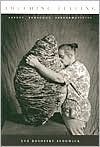Touching Feeling: Affect, Pedagogy, Performativity
A pioneer in queer theory and literary studies, Eve Kosofsky Sedgwick brings together for the first time in Touching Feeling her most powerful explorations of emotion and expression. In essays that show how her groundbreaking work in queer theory has developed into a deep interest in affect, Sedgwick offers what she calls "tools and techniques for nondualistic thought," in the process touching and transforming such theoretical discourses as psychoanalysis, speech-act theory, Western Buddhism,...
Search in google:
A pioneer in queer theory and literary studies, Eve Kosofsky Sedgwick brings together for the first time in Touching Feeling her most powerful explorations of emotion and expression. In essays that show how her groundbreaking work in queer theory has developed into a deep interest in affect, Sedgwick offers what she calls "tools and techniques for nondualistic thought," in the process touching and transforming such theoretical discourses as psychoanalysis, speech-act theory, Western Buddhism, and the Foucauldian "hermeneutics of suspicion." In prose sometimes somber, often high-spirited, and always accessible and moving, Touching Feeling interrogates-through virtuoso readings of works by Henry James, J. L. Austin, Judith Butler, the psychologist Silvan Tomkins and others-emotion in many forms. What links the work of teaching to the experience of illness? How can shame become an engine for queer politics, performance, and pleasure? Is sexuality more like an affect or a drive? Is paranoia the only realistic epistemology for modern intellectuals? Ultimately, Sedgwick's unfashionable commitment to the truth of happiness propels a book as open-hearted as it is intellectually daring. About the Author Eve Kosofsky Sedgwick is Distinguished Professor of English at the CUNY Graduate Center. She is the author of numerous books including A Dialogue on Love and Epistemology of the Closet. Her books Tendencies; Fat Art, Thin Art, a book of poetry; Novel Gazing: Queer Readings in Fiction; and Shame and Its Sisters: A Silvan Tomkins Reader (coedited with Adam Frank) are published by Duke University Press.Q Syndicate Book MarksThese collected essays brush, with a graceful,soulful touch, across such topics as how illness (her own cancer) shapes her teaching, or shame provokes queer empowerment, or paranoia (her own fears) fires up intellectual daring. Sedgwick, a queer-identified straight academic, is a challenging, truly original thinker. Her muse - borne by electric, almost erotic language - is too stimulating to shun merely because it's not simple.—Richard Labonte
Touching feeling\ Affect, pedagogy, performativity \ \ By Eve Kosofsky Sedgwick \ Duke University Press\ \ ISBN: 0-8223-3015-6 \ \ \ \ Chapter One\ SHAME, THEATRICALITY, AND QUEER PERFORMATIVITY: HENRY JAMES'S \ The Art of the Novel\ * * *\ In the couple of weeks after the World Trade Center was destroyed in September 2001, I had a daily repetition of an odd experience, one that was probably shared by many walkers in the same midsouthern latitudes of Manhattan. Turning from a street onto Fifth Avenue, even if I was heading north, I would feel compelled first to look south in the direction of the World Trade Center, now gone. This inexplicably furtive glance was associated with a conscious wish: that my southward vista would again be blocked by the familiar sight of the pre-September 11 twin towers, somehow come back to loom over us in all their complacent ugliness. But, of course, the towers were always still gone. Turning away, shame was what I would feel.\ Why shame? I think this was, in effect, one of those situations in which, as Silvan Tomkins puts it, "one is suddenly looked at by one who is strange, or ... one wishes to look at or commune with another person but suddenly cannot because he is strange, or one expected him to be familiar but he suddenly appears unfamiliar, or one started to smile but found one was smiling at a stranger" (Shame 135). Not that an urban vista is quite the same as a loved face, but it isn't quitedifferent, either: the despoiled view was a suddenly toothless face, say, or suddenly preoccupied, or suddenly dead-to say nothing, even, of the historical implications surrounding that particular change of landscape.\ These flashes of shame didn't seem particularly related to prohibition or transgression. Beyond that, though it was I who felt the shame, it wasn't especially myself I was ashamed of. It would be closer to say I was ashamed for the estranged and denuded skyline; such feelings interlined, of course, the pride, solidarity, and grief that also bound me to the city. The shame had to do, too, with visibility and spectacle-the hapless visibility of the towers' absence now, the shockingly compelling theatricality of their destruction.\ Recent work by theorists and psychologists of shame locates the protoform (eyes down, head averted) of this powerful affect-which appears in infants very early, between the third and seventh month of life, just after the infant has become able to distinguish and recognize the face of its caregiver-at a particular moment in a particular repeated narrative. That is the moment when the circuit of mirroring expressions between the child's face and the caregiver's recognized face (a circuit that, if it can be called a form of primary narcissism, suggests that narcissism from the very first throws itself sociably, dangerously into the gravitational field of the other) is broken: the moment when the adult face fails or refuses to play its part in the continuation of mutual gaze; when, for any one of many reasons, it fails to be recognizable to, or recognizing of, the infant who has been, so to speak, "giving face" based on a faith in the continuity of this circuit. As Michael Franz Basch explains, "The infant's behavioral adaptation is quite totally dependent on maintaining effective communication with the executive and coordinating part of the infant-mother system. The shame-humiliation response, when it appears, represents the failure or absence of the smile of contact, a reaction to the loss of feedback from others, indicating social isolation and signaling the need for relief from that condition" (765). The protoaffect shame is thus not defined by prohibition (nor, as a result, by repression). Shame floods into being as a moment, a disruptive moment, in a circuit of identity-constituting identificatory communication. Indeed, like a stigma, shame is itself a form of communication. Blazons of shame, the "fallen face" with eyes down and head averted-and, to a lesser extent, the blush-are semaphores of trouble and at the same time of a desire to reconstitute the interpersonal bridge.\ But in interrupting identification, shame, too, makes identity. In fact, shame and identity remain in very dynamic relation to one another, at once deconstituting and foundational, because shame is both peculiarly contagious and peculiarly individuating. One of the strangest features of shame, but perhaps also the one that offers the most conceptual leverage for political projects, is the way bad treatment of someone else, bad treatment by someone else, someone else's embarrassment, stigma, debility, bad smell, or strange behavior, seemingly having nothing to do with me, can so readily flood me-assuming I'm a shame-prone person-with this sensation whose very suffusiveness seems to delineate my precise, individual outlines in the most isolating way imaginable.\ Lecturing on shame, I used to ask listeners to join in a thought experiment, visualizing an unwashed, half-insane man who would wander into the lecture hall mumbling loudly, his speech increasingly accusatory and disjointed, and publicly urinate in the front of the room, then wander out again. I pictured the excruciation of everyone else in the room: each looking down, wishing to be anywhere else yet conscious of the inexorable fate of being exactly there, inside the individual skin of which each was burningly aware; at the same time, though, unable to stanch the hemorrhage of painful identification with the misbehaving man. That's the double movement shame makes: toward painful individuation, toward uncontrollable relationality.\ The conventional way of distinguishing shame from guilt is that shame attaches to and sharpens the sense of what one is, whereas guilt attaches to what one does. Although Tomkins is less interested than anthropologists, moralists, or popular psychologists in distinguishing between the two, the implication remains that one is something in experiencing shame, though one may or may not have secure hypotheses about what. In the developmental process, shame is now often considered the affect that most defines the space where in a sense of self will develop ("Shame is to self psychology what anxiety is to ego psychology-the keystone affect" [Broucek 369]). Which I take to mean, not at all that it is the place where identity is most securely attached to essences, but rather that it is the place where the question of identity arises most originarily and most relationally.\ At the same time, shame both derives from and aims toward sociability. As Basch writes, "The shame-humiliation reaction in infancy of hanging the head and averting the eyes does not mean the child is conscious of rejection, but indicates that effective contact with another person has been broken.... Therefore, shame-humiliation throughout life can be thought of as an inability to effectively arouse the other person's positive reactions to one's communications. The exquisite painfulness of that reaction in later life harks back to the earliest period when such a condition is not simply uncomfortable but threatens life itself " (765-66). So that whenever the actor, or the performance artist, or, I could add, the activist in an identity politics, proffers the spectacle of her or his "infantile" narcissism to a spectating eye, the stage is set (so to speak) for either a newly dramatized flooding of the subject by the shame of refused return, or the successful pulsation of the mirroring regard through a narcissistic circuit rendered elliptical (which is to say: necessarily distorted) by the hyperbole of its original cast. As best described by Tomkins, shame effaces itself; shame points and projects; shame turns itself skin side out; shame and pride, shame and dignity, shame and self-display, shame and exhibitionism are different interlinings of the same glove. Shame, it might finally be said, transformational shame, is performance. I mean theatrical performance. Performance interlines shame as more than just its result or a way of warding it off, though importantly it is those things. Shame is the affect that mantles the threshold between introversion and extroversion, between absorption and theatricality, between performativity and-performativity.\ Henry James undertook the New York edition of his work (a handsome twenty-four-volume consolidation and revision, with new prefaces, of what he saw as his most important novels and stories to date) at the end of a relatively blissful period of literary production ("the major phase")-a blissful period poised, however, between two devastating bouts of melancholia. The first of these scouring depressions was precipitated in 1895 by what James experienced as the obliterative failure of his ambitions as a playwright, being howled off the stage at the premiere of Guy Domville. By 1907, though, when the volumes of the New York edition were beginning to appear, James's theatrical self-projection was sufficiently healed that he had actually begun a new round of playwrighting and of negotiations with producers-eventuating, indeed, in performance. The next of James's terrible depressions was triggered, not by humiliation on the stage, but by the failure of the New York edition itself: its total failure to sell and its apparently terminal failure to evoke any recognition from any readership.\ When we read the New York edition prefaces, then, we read a series of texts that are in the most active imaginable relation to shame. Marking and indeed exulting in James's recovery from a near-fatal episode of shame in the theater, the prefaces, gorgeous with the playful spectacle of a productive and almost promiscuously entrusted or "thrown" authorial narcissism, yet also offer the spectacle of inviting (that is, leaving themselves open to) what was in fact their and their author's immediate fate: annihilation by the blankest of nonrecognizing responses from any reader. The prefaces are way out there, in short, and in more than a couple of senses of out.\ In them, at least two different circuits of the hyperbolic narcissism/shame orbit are being enacted, and in a volatile relation to each other. The first of these, as I've suggested, is the drama of James's relation to his audience of readers. In using the term "audience" here, I want to mark James's own insistent thematization of elements in this writing as specifically theatrical, with all the implications of excitement, overinvestment, danger, loss, and melancholia that, as Joseph Litvak has argued in Caught in the Act, the theater by this time held for him. The second and related narcissism/shame circuit dramatized in the prefaces is the perilous and productive one that extends between the speaker and his own past. James's most usual gesture in the prefaces is to figure his relation to the past as the intensely charged relationship between the author of the prefaces and the often much younger man who wrote the novels and stories to which the prefaces are appended-or between either of these men and a yet younger figure who represents the fiction itself.\ What undertaking could be more narcissistically exciting or more narcissistically dangerous than that of rereading, revising, and consolidating one's own "collected works"? If these, or their conjured young author, return one's longing gaze with dead, indifferent, or even distracted eyes, what limit can there be to the shame (of him, of oneself ) so incurred? Equal to that danger, however, is the danger of one's own failure to recognize or to desire them or him. As Tomkins writes, "Like disgust, [shame] operates only after interest or enjoyment has been activated, and inhibits one or the other or both. The innate activator of shame is the incomplete reduction of interest or joy. Hence any barrier to further exploration which partially reduces interest ... will activate the lowering of the head and eyes in shame and reduce further exploration or self-exposure" (Shame 135). To consider interest itself a distinct affect and to posit an association between shame and (the [incomplete] inhibition of ) interest makes sense phenomenologically, I think, about depression, and specifically about the depressions out of which James had emerged to write his "major novels"-novels that do, indeed, seem to show the effects of a complicated history of disruptions and prodigal remediations in the ability to take an interest. Into such depressions as well, however, he was again to be plunged. The James of the prefaces revels in the same startling metaphor that animates the present-day popular literature of the "inner child": the metaphor that presents one's relation to one's own past as a relationship, intersubjective as it is intergenerational. And, it might be added, for most people by definition homoerotic. Often, the younger author is present in these prefaces as a figure in himself, but even more frequently the fictions themselves, or characters in them, are given his form. One needn't be invested (as pop psychology is) in a normalizing, hygienic teleology of healing this relationship, in a mawkish overvaluation of the "child" 's access to narrative authority at the expense of that of the "adult," or in a totalizing ambition to get the two selves permanently merged into one, to find that this figuration opens out a rich landscape of relational positionalities-perhaps especially around issues of shame. James certainly displays no desire to become once again the young and mystified author of his early productions.To the contrary, the very distance of these inner self-figurations from the speaking self of the present is marked, treasured, and in fact eroticized. Their distance (temporal, figured as intersubjective, figured in turn as spatial) seems, if anything, to constitute the relished internal space of James's absorbed subjectivity. Yet for all that the distance itself is prized, James's speculation as to what different outcomes might be evoked by different kinds of overture across the distance-by different sorts of solicitation, different forms of touch, interest, and love between the less and the more initiated figure-provides a great deal of the impetus to his theoretical project in these essays. The speaking self of the prefaces does not attempt to merge with the potentially shaming or shamed figurations of its younger self, younger fictions, younger heroes; its attempt is to love them. That love is shown to occur both in spite of shame and, more remarkably, through it.\ Not infrequently, as we'll see, the undertaking to reparent, as it were, or "reissue" the bastard infant of (what is presented as) James's juvenilia is described simply as male parturition. James also reports finding in himself "that finer consideration hanging in the parental breast about the maimed or slighted, the disfigured or defeated, the unlucky or unlikely child-with this hapless small mortal thought of further as somehow 'compromising'" (Art 80-81). James offers a variety of reasons for being embarrassed by these waifs of his past, but the persistence with which shame accompanies their repeated conjuration is matched by the persistence with which, in turn, he describes himself as cathecting or eroticizing that very shame as a way of coming into loving relation to queer or "compromising" youth.\ (Continues...)\ \ \ \ \ Excerpted from Touching feeling by Eve Kosofsky Sedgwick Excerpted by permission.\ All rights reserved. No part of this excerpt may be reproduced or reprinted without permission in writing from the publisher.\ Excerpts are provided by Dial-A-Book Inc. solely for the personal use of visitors to this web site. \ \
AcknowledgmentsIntroduction1Interlude, Pedagogic271Shame, Theatricality, and Queer Performativity: Henry James's The Art of the Novel352Around the Performative: Periperformative Vicinities in Nineteenth-Century Narrative673Shame in the Cybernetic Fold: Reading Silvan Tomkins934Paranoid Reading and Reparative Reading, or, You're So Paranoid, You Probably Think This Essay Is About You1235Pedagogy of Buddhism153Works Cited183Index189
\ From the Publisher“Eve Kosofsky Sedgwick writes with intense precision, and yet her work directs us toward the domain where meaning is music, unquantifiable, enigmatic, nonlinguistic. If the performative speech act, with all its relation to norms and laws, is central to the reception of her work in queer theory, then the performativity of knowledge beyond speech—aesthetic, bodily, affective—is its real topic.”—Lauren Berlant, author of The Queen of America Goes to Washington City\ “Eve Kosofsky Sedgwick's gift is to electrify intellectual communities by reminding them that ’thought’ has a temperature, a texture, and an erotics. With a generosity that is at once self-abnegatingly ascetic, and gorgeously, exhibitionistically bravura, she opens door after door onto undiscovered fields of inquiry. There are too many high points in Touching Feeling for me to list them. Sedgwick's language, richly garlanded, syntactically showstopping, gives, everywhere, its characteristic, always surprising pleasure.”—Wayne Koestenbaum, author of Andy Warhol\ \ \ \ \ \ Publishers WeeklyFearless, challenging and occasionally exhilarating, Sedgwick remains one of the most courageous critics around.\ \ \ Q Syndicate Book MarksThese collected essays brush, with a graceful,soulful touch, across such topics as how illness (her own cancer) shapes her teaching, or shame provokes queer empowerment, or paranoia (her own fears) fires up intellectual daring. Sedgwick, a queer-identified straight academic, is a challenging, truly original thinker. Her muse - borne by electric, almost erotic language - is too stimulating to shun merely because it's not simple.—Richard Labonte\ \ \ \ \ Publishers WeeklyThese essays, "a palimpsest of previously published and unpublished material," find Sedgwick expanding her impressive critical powers to areas beyond literature and politics. Though she's best known for her work in queer theory (Epistemology of the Closet), Sedgwick has always been interested in "performativity"-how people embody linguistic and non-linguistic concepts. Sedgwick has hardly abandoned explorations of queerness-an essay on shame and Henry James's The Art of the Novel is about as queer as theory gets-but these five pieces find her attuned to the textures of things, and to things themselves. Her readings-of everything from Thackeray to "my friends who are thirty"-take on a sensual quality, exploring the connections between "phenomenology and affect" and "what motivates performativity and performance" and "what individual and collective effects are mobilized in their execution." Fearless, challenging and occasionally exhilarating, Sedgwick remains one of the most courageous critics around. (Feb.) Copyright 2003 Reed Business Information.\ \








